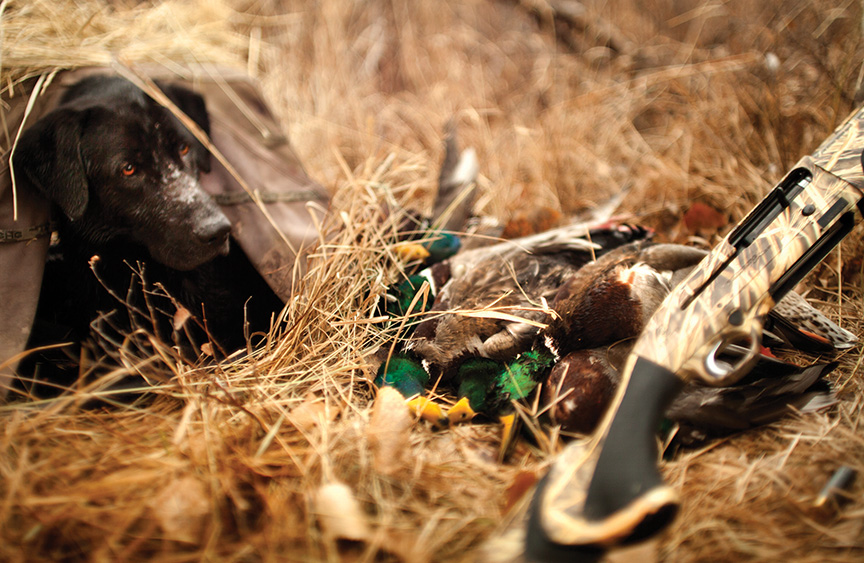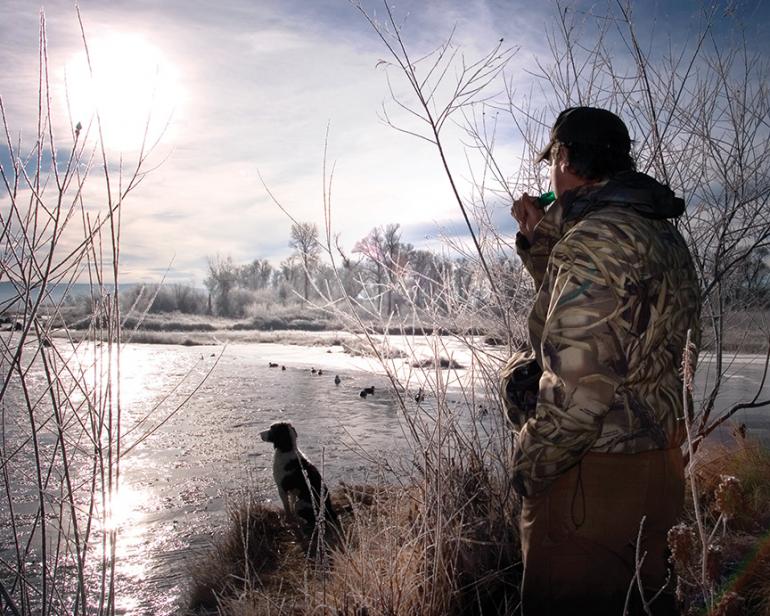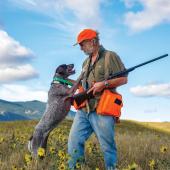Fowl Play
It’s the opening day of Montana waterfowl season on a prairie pothole north of Bozeman. The wind is calm, and the water’s surface offers the perfect reflection of a gorgeous sunrise. Forget the Duck Commander get-up. My “camo” is a plaid cotton shirt and a baseball cap.
Nothing fancy about my blind, either. I’m just sitting on a bucket in a clump of reeds. In fact, the only classical components of a duck hunt this morning are the decoys sitting lifelessly on the water, a shotgun, and my dog Rosy, a young female yellow Lab who is already a better duck hunter than I am.
Legal shooting light still lies 15 minutes away by the time I’ve settled in, but I’m enjoying the wait. Dark shapes hurtle by overhead. Ripples suddenly rock the decoys as a pair of teal appears from nowhere and lands. The anticipation reminds me of Christmas morning as a kid, when waiting for parental permission to attack the tree proved more exciting than opening the presents.
Finally, the minute hand on my watch crawls past the starting line. The first pair of teal has already smelled a rat and departed, but a flock of six arrives over the decoys ready to take their place. The short-range shooting is kid stuff. At my command, Rosy launches like a missile to start picking up dinner.
That’s a thumbnail sketch of Montana duck hunting in early October. But another three months of the season remain, and as we shall see, duck hunting in January is a very different business.
Habitat
To state the obvious, the sine qua non of waterfowl habitat is water. Montana’s early-season duck populations depend on local spring rainfall, especially along the Hi-Line. By November, though, we’ll be hunting migrating northern ducks whose numbers reflect precipitation on the Canadian prairies during the crucial summer nesting season.

With some welcome exceptions (Lake Mason, Freezout Lake), Montana south of the Hi-Line doesn’t contain many of the large wetlands that provide good hunting elsewhere. As long as locally bred ducks are still around, that doesn’t matter much. As the opening vignette suggests, less can be more in October.
The whole game changes when lakes and ponds start to freeze. Then the Bozeman area offers an embarrassment of riches, thanks to its large number of ice-resistant, spring-fed creeks. Migrating ducks know all about them and utilize them in large numbers. Big rivers like the Yellowstoneusually remain open too, and can provide a totally different hunting experience during the late season as long as you have a tough retriever. The fields where ducks feed provide additional opportunities away from water.
Behavior
Ducks are naturally wary birdswith keen vision. The longer the season progresses, the warier they become. You won’t get away with my casual opening-day approach when hunting large flocks of late-season mallards. Concealment becomes crucial then.
A number of factors influence duck behavior in ways that affect hunting, including wind and time of day. Wind makes sitting in a blind less comfortable during the late season (a great argument for high-quality clothing then), but it makes ducks move. Hunters can expect ducks to fly at first light, but then it becomes a matter of waiting for them to return to water after feeding in fields. The key is patience.
Gear
Duck hunters are gearheads, and non-hunting spouses should be warned. The choice of shotguns may be the least important equipment decision a novice makes, but it is likely the most talked about. Long-barreled, tight-choked 12-gauge pumps and autoloaders are traditional choices for waterfowlers, and the majority of duck hunters today still choose guns with most of those characteristics. Sixty years of experience have left me an outlier regarding shotguns. I prefer doubles because of their balance, simplicity, and aesthetic appeal. The principle advantage of a pump or automatic is a third shot, which seldom does me much good. If I haven’t got the job done with two shells, it’s time to stop shooting.
Hunting ducks over decoys where shots are close and controlled largely eliminates the need for tight chokes, if you’re a good hunter. During late-season spring-creek hunts, I’m usually happy with a 20-gauge. Of course, this recommendation changes if you’re pass-shooting goldeneyes on the Yellowstone in December. That’s why we all need so many shotguns to choose from.
Duck hunters need to remember that non-toxic shotis legally mandatory. Be sure to clear all of the lead loads out of your coat before duck season. I usually shoot #4s over decoys. Remember that it’s illegal to hunt waterfowl with a gun that holds more than three shells. If you’ve chosen a pump or autoloader, make sure its magazine is plugged.
Clothingreally matters during the late season. Since bitter cold concentrates ducks on the spring creeks, frigid weather means better hunting. I hunt a lot of late-season waterfowl in sub-zero temperatures. Sitka Gear makes a great choice then. It’s wind-resistant and allows layering to just the right R-factor (thermal resistance) without making me too bulked-up to swing my shotgun. Besides, the company is based right here in Bozeman.
The most important piece of “gear” in the duck hunter’s world may not be gear at all. I wouldn’t bother getting out of bed to shoot a limit of mallards if I didn’t have one of my dogs at my side. A capable retriever can all but eliminate lost birds. I think hunting without one borders on the unethical, and there’s just no better company in a duck blind than a wet Lab. Mine are like family.

Regs
In contrast to upland birds, waterfowl regulations are governed by federal law. Seasons and limits vary by flyway, and the boundary between the Central and Pacific flyways runs right down the middle of Montana. What’s legal in Gallatin County may not be legal in Park County and vice versa. Know what flyway you’re in and which set of rules applies.
Seasons and limits are determined annually, so the best I can offer here is generalization. Duck season usually opens in late September or early October and ends early to mid-January. Montana offers a two-day early youth season. Limits include sub-quotas on ducks like pintails, canvasbacks, hen mallards, and others. Know your ducks!
Montana offers outstanding hunting for a wide variety of game. Despite our dry climate, waterfowl are no exception for those willing to study the birds, their behavior, and their habitat. Best of all, determined hunters willing to brave the elements until the bitter end can enjoy two markedly different outdoor experiences. The Bozone is a great place to do it.
Save for some time spent in Alaska, Don Thomas has lived in central Montana for over 40 years, and his wife Lori is a fourth-generation Montanan. Don has raised and trained retrievers for decades, and he and Lori have written about and photographed waterfowl hunting for numerous national publications.
This article originally appeared in Stalk hunting guide, an annual guide to hunting in southwest Montana.












